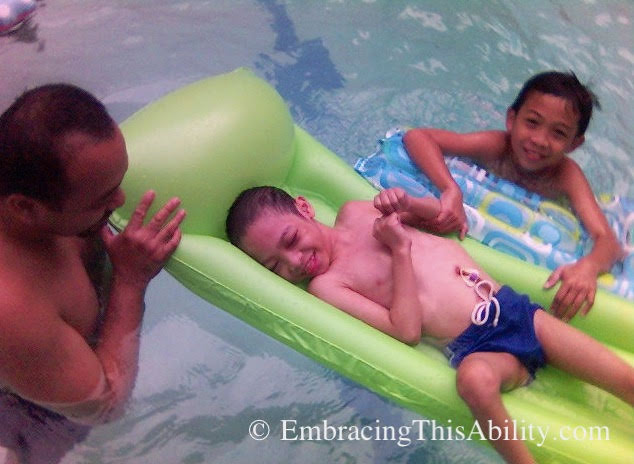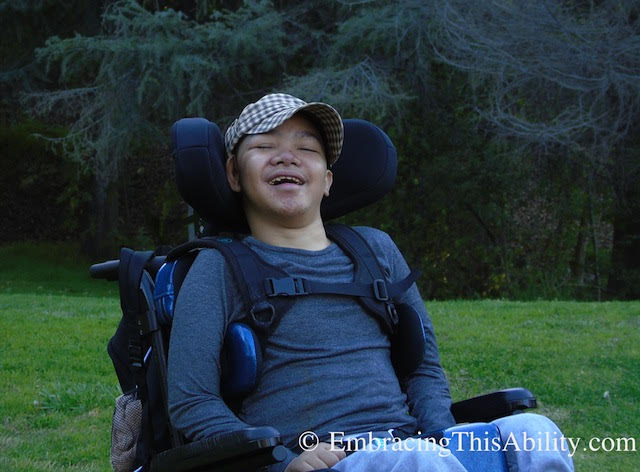“Failure to thrive.” That’s a medical diagnosis that any parent wouldn’t want to hear about their child with special needs. But that was what we got many years ago. Our son wasn’t gaining any weight and continued to get thinner and thinner as his dysphagia (swallowing difficulties) worsened.

Ironically, James looked like a healthy baby before he turned one. But his inability to keep food down due to various factors, including GERD (gastroesophageal reflux disease) which made him constantly throw up food, eventually led to very poor health.

Our son was around four and a half years old in 2002 when we were advised by his neurologist to consult a gastroenterologist about feeding him through an NGT (nasogastric tube), a tube that is inserted through a patient’s nose going down directly to the stomach. We also consulted a nutritionist who gave us guidelines about different kinds of food to blend so we can alternate between blenderized and complete formula feeding because the latter is very expensive and we couldn’t afford having it as James’ only nutrition source.

For three and a half years, my son was fed through the tube in his nose. The sad thing is, none of his numerous doctors told us that tube-fed kids should only be fed for a short while through the NGT. This, I found out much later, is to prevent trauma along the tube pathways (imagine the throat being scratched each time a tube is inserted and pulled out) and also to minimize chances of food and acid to back up into the throat or airways (because the sphincter muscle between the pharynx and esophagus is always open).

Thankfully, when internet access was finally possible in the Philippines, I found a lot of resources online that educated me a lot about tubefeeding. I signed up as a member of a few Yahoo Groups for special needs parents and learned a lot from tubefeeding experiences shared by US-based moms. They gave me the push to explore the possibility of transitioning my son to a PEG (percutaneous endoscopic gastrostomy) tube.

(this was still in the Philippines)
After months of raising funds (with the help of generous friends in the US) for the surgery, James finally got a PEG when he was seven years old. While the long tube protruding out of his tummy can be unwieldy sometimes, it was a huge improvement from the NGT. Significantly, the bouts of pneumonia tapered off and we were able to breathe a bit from all the financial strain of frequent hospital admissions.

It took another two years before we could afford to have the PEG (that cost PhP8,000 at the time) changed to a low-profile gastrostomy tube (worth PhP15,000), which was more expensive. At the time, our doctor chose to use a Bard button that has a fixed umbrella type end instead of the Mic-key button with a balloon end. She explained that the Bard is more secure and would be less likely to be accidentally pulled out while the Mic-key’s balloon might suddenly deflate and we might find ourselves without any immediate replacement.
Now that our family is based in the US, we are very grateful to have access to replacement Mic-key buttons through our health insurance. After the initial switch from Bard to Mic-key two years ago where the doctor showed us how to change the button ourselves, I am able to do it at home without needing to bring James to the hospital anymore.

I am sharing our story to encourage fellow parents (especially those in the Philippines and other developing countries) who have kids being fed through NGT for a long time to consider surgery to put in a PEG. After the initial discomforts of recovery, your child would be more comfortable and pain-free from all the inserting and taping of the tube on the side of his/her nose.
Note: I hope this blog post was able to answer your questions or even allay your fears. I am not a medical professional though so please make sure to discuss your options with your doctor.


Saan po s pinas maganda magpakabit ng PEG? pano po nyo din po nakuha ng visa si james? Yan din po gusto ng sistèr ko kc mkarating baby ko dyn para mas mapatingnan ng maayos po baby ko
Hi Gail, we had James’ PEG insertion done at Chinese General Hospital by Dr. Grace Uy. I know some families who had theirs done at PCMC.
As to the US visa, please read our migration story, here: http://mommywrites.blogspot.com/2018/08/home-is-where-heart-is-our-familys.html
Thank you for reading. I hope you found the information helpful.
Hello po ma’am,,, anu po pla ung case ni James?ung s anak ko po kc lissencephaly, cerebral hypotonia, epilepsy, GDD s tingin nyo po b my pag asa p po ang anak ko n gumaling sinsya n po kau kc wla po tlga akong knowledge about this kind of condition
Hi Aiza, James was diagnosed with spastic quadriplegic cerebral palsy. Marami pa rin syang medical issues na kailangang i-manage gaya ng pag-maintain ng seizure medications, pagne-nebulize araw-araw, etc. Hindi sya nakakapagsalita at nakakalakad. Pero masayahin syang bata.
Dahil iba-iba ang development ng mga anak natin, mahirap magsabi kung gagaling ang isang bata mula sa kanyang mga diagnosis. Ang mahalaga, patuloy nating gawin ang lahat ng kaya natin para maging masaya at kumportable ang buhay nila.
I suggest i-discuss mo yung mga concerns mo sa doctors na tumitingin sa anak mo. I’m sure mas mabibigyan ka nila ng tamang information. Basta huwag kang mawawalan ng pag-asa 🙏